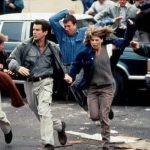The Road Warrior (1982)

The Road Warrior, also known as Mad Max 2, is a groundbreaking film that redefined the post-apocalyptic action genre. Directed by the visionary George Miller and released in 1982, it serves as the second installment in the Mad Max series, following the original Mad Max (1979). Featuring Mel Gibson in his iconic role as Max Rockatansky, The Road Warrior immerses audiences in a stark, dystopian world where societal structures have crumbled, and survival is a daily struggle. With its stunning visuals, high-octane action, and rich themes, the film has left an indelible mark on both action cinema and popular culture.
The narrative unfolds in a bleak and desolate future, set against the backdrop of a world ravaged by environmental disaster and societal collapse. The film introduces viewers to a vast wasteland, characterized by arid landscapes, rusting vehicles, and the remnants of a once-thriving civilization. This setting is not merely a backdrop; it functions as a character in its own right, contributing to the pervasive atmosphere of despair, danger, and lawlessness. The desolation highlights the survivalist mentality of the characters, creating a visceral sense of urgency and tension that propels the story forward.
Max Rockatansky, portrayed by Mel Gibson, is a former police officer turned lone warrior navigating this ruthless landscape. Haunted by the loss of his family and the atrocities he has witnessed, Max embodies the archetype of the reluctant hero. His journey throughout the film is not just a physical battle against marauders; it is also an internal struggle with grief and the search for redemption. Max’s character is defined by his gritty resilience and pragmatism, making him a relatable figure in a world stripped of morality and compassion.
The film’s central conflict revolves around the struggle for resources, particularly gasoline, which has become a precious commodity in this post-apocalyptic society. The plot follows Max as he encounters a group of survivors living in a fortified compound, desperately trying to protect their oil reserves from a violent gang led by the menacing Humungus (Kjell Nilsson). This clash between the protagonists and the antagonists highlights the film’s exploration of power dynamics and the lengths to which individuals will go to secure their survival.

One of the film’s most striking features is its breathtaking action sequences, which set a new standard for the genre. George Miller’s masterful direction combines practical effects with innovative stunt work, resulting in adrenaline-fueled car chases and explosive confrontations. The iconic vehicles, from the modified trucks to the sleek motorcycles, are meticulously designed, adding to the film’s gritty aesthetic. These high-octane pursuits not only serve as thrilling spectacles but also reflect the characters’ desperation and determination to survive in a chaotic world.

The cinematography by Dean Cundey plays a pivotal role in shaping the film’s visual style. The sweeping desert landscapes, combined with tight close-ups of the characters, create a sense of isolation and vulnerability. The use of natural light enhances the stark beauty of the wasteland, emphasizing the harsh realities faced by the characters. Cundey’s work effectively captures both the grandeur of the desolation and the intimacy of the characters’ struggles, immersing audiences in their plight.
Another noteworthy aspect of The Road Warrior is its minimalistic yet impactful storytelling. The film eschews excessive dialogue in favor of visual storytelling, allowing the actions of the characters to convey their emotions and motivations. This approach adds to the film’s urgency and intensity, creating a sense of immediacy that keeps viewers engaged. Max’s journey is marked by moments of quiet reflection amid the chaos, providing insight into his character while maintaining the film’s relentless pace.

The score, composed by Brian May, further enhances the film’s emotional depth. The music oscillates between haunting melodies and aggressive themes, mirroring the tension and action on screen. May’s compositions elevate the stakes of each scene, drawing audiences deeper into the harrowing experiences of Max and the survivors. The score serves as an emotional anchor, underscoring the characters’ struggles and triumphs in the face of overwhelming odds.
The Road Warrior also delves into themes of community and sacrifice. While Max initially appears to be a lone wolf, his interactions with the survivors challenge his isolationist mentality. The film explores the importance of collaboration and collective strength in the face of adversity. The climactic showdown between the survivors and Humungus’s gang exemplifies this theme, as they unite to defend their home and resources. Max’s gradual acceptance of their community signifies his journey towards healing and redemption, highlighting the transformative power of connection.

In conclusion, The Road Warrior stands as a seminal work in the post-apocalyptic action genre, blending breathtaking action, profound themes, and rich character development. George Miller’s visionary direction, coupled with Mel Gibson’s unforgettable performance, creates a film that resonates on multiple levels. Through its exploration of survival, community, and the search for redemption, The Road Warrior remains a compelling reflection on the human condition in a world stripped of civilization. Its influence continues to shape the landscape of action cinema, solidifying its status as a timeless classic that invites audiences to reflect on the fragility of society and the resilience of the human spirit.
Suggested videos for you:
Suggested videos for you:











